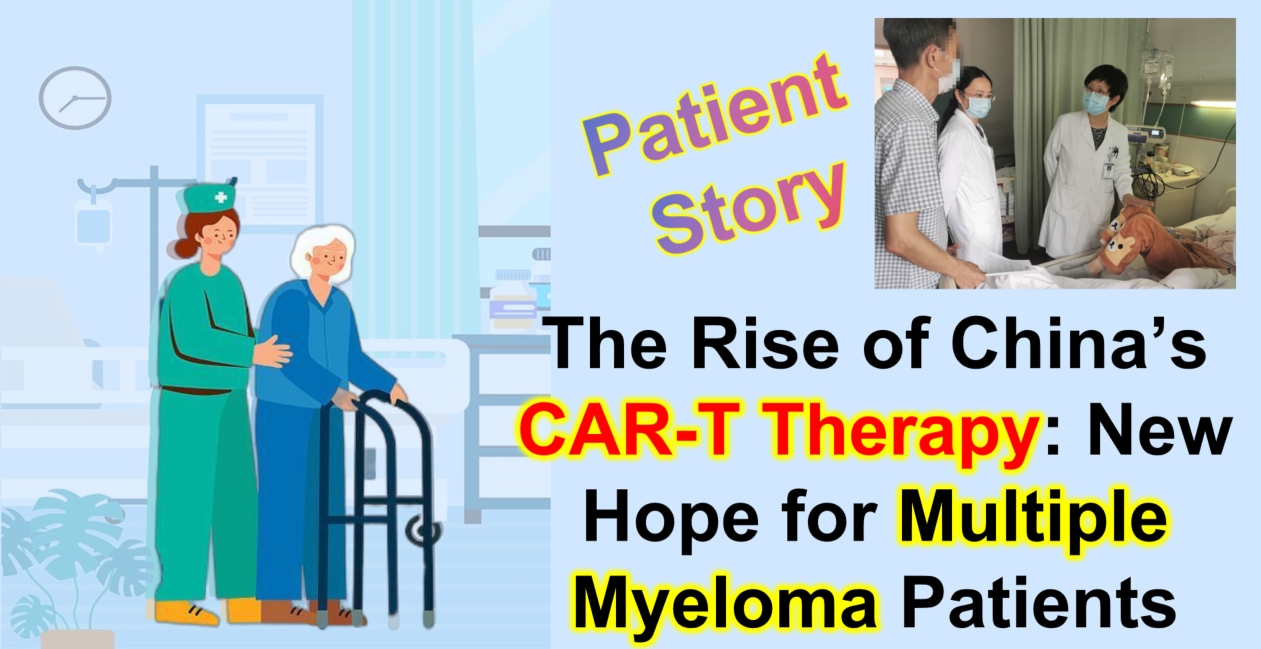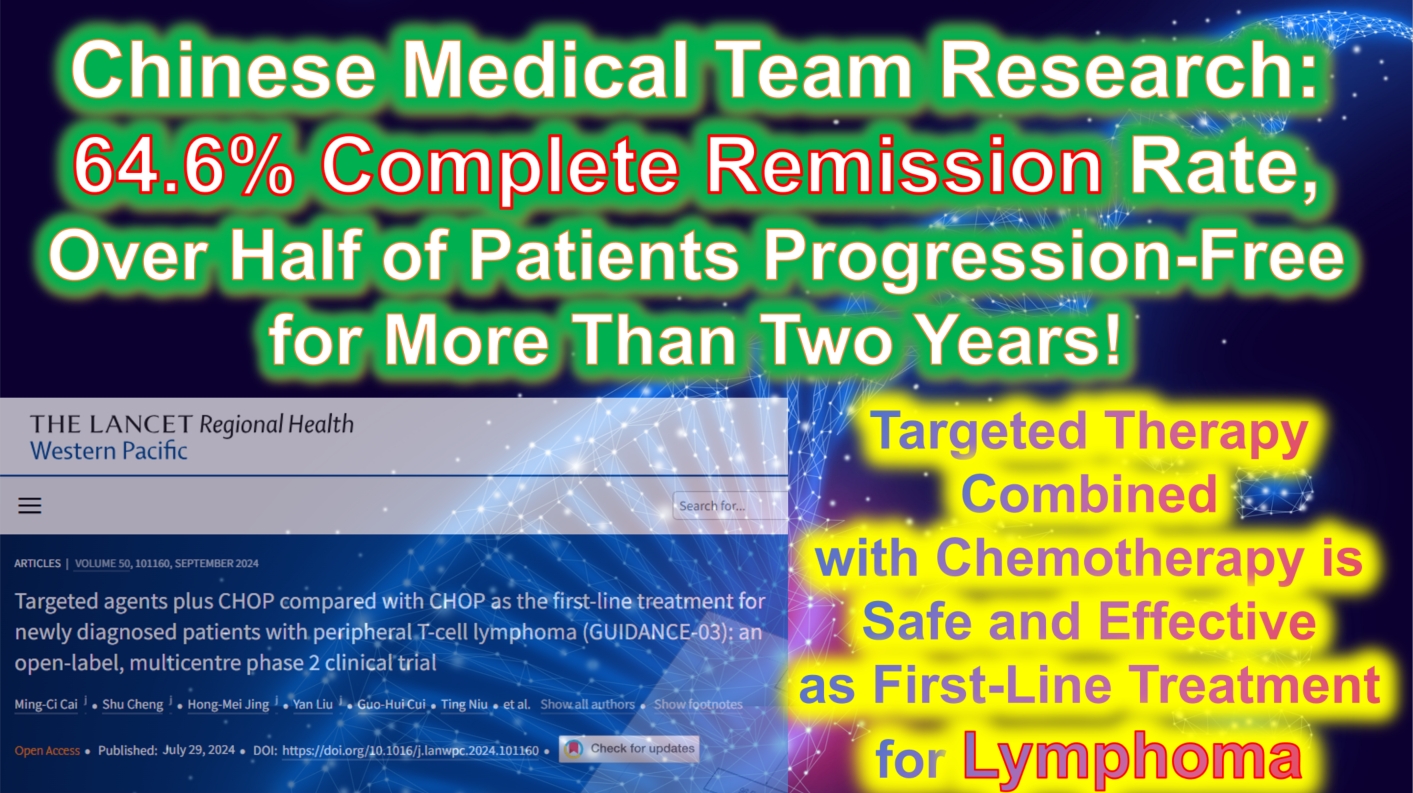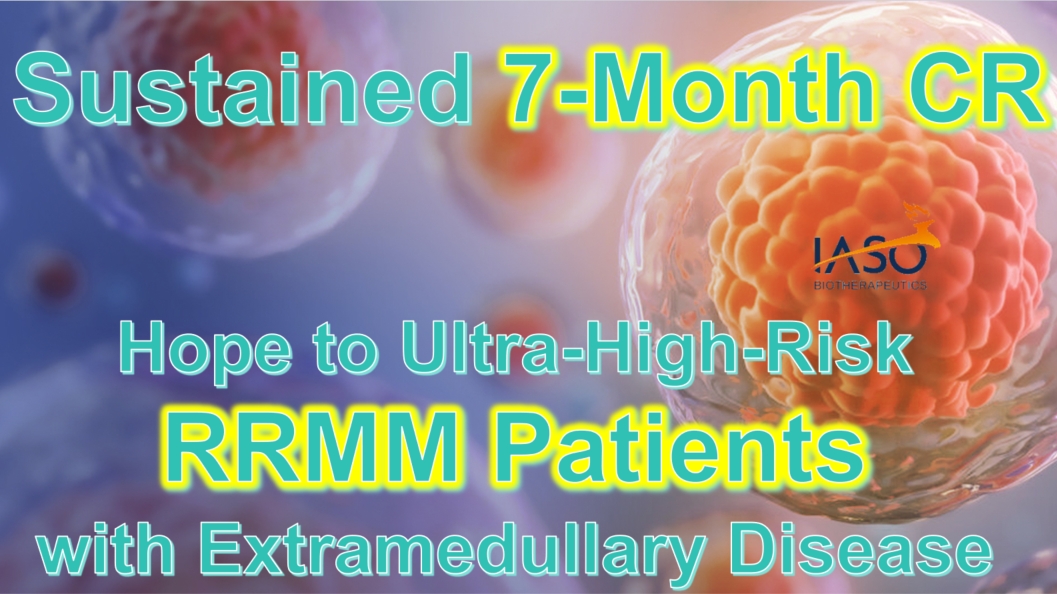Warning: Trying to access array offset on value of type bool in /www/wwwroot/www.medtourcn.com/wp-content/themes/medical-directory/framework/theme/medicaldirectory-image.php on line 78
Warning: Trying to access array offset on value of type bool in /www/wwwroot/www.medtourcn.com/wp-content/themes/medical-directory/framework/theme/medicaldirectory-image.php on line 79

The Rise of China’s CAR-T Therapy: New Hope for Multiple Myeloma Patients
**The Rise of China’s CAR-T Therapy: New Hope for Multiple Myeloma Patients**

Multiple Myeloma
#CARTTherapy #CART #MultipleMyeloma #BloodCancer #patientstory
China’s CAR-T cell therapy has emerged as a highly effective and proactive option for treating relapsed and refractory multiple myeloma, bringing new hope to patients facing limited treatment options. This innovative therapy has shown significant effectiveness in clinical practice, offering renewed optimism to both patients and doctors.
Recently, a team of hematology experts from Zhejiang Hospital visited a 72-year-old multiple myeloma patient who had just begun treatment with a domestically developed CAR-T therapy targeting BCMA. This patient, suffering from severe bone pain and difficulty walking, sought help from the Advanced Medicine In China team. Following a thorough consultation, the experts arranged for the patient’s hospitalization. After multiple rounds of traditional chemotherapy and an autologous stem cell transplant, the disease had unfortunately relapsed, prompting the medical team to recommend CAR-T therapy as an alternative.
As one of the first in China to implement CAR-T therapy for multiple myeloma, Zhejiang’s hematology team has accumulated significant clinical experience with this treatment. “The patient’s overall response to treatment has been very positive,” said one of the experts, noting that follow-up examinations showed stable results, confirming the therapy’s efficacy and safety.
Multiple myeloma is a malignant plasma cell disorder primarily affecting older adults; however, it has been seen with increasing frequency in younger patients, including some in their forties. While the disease remains incurable, recent advancements in new drugs and treatment options have greatly improved patient survival times and quality of life.
CAR-T therapy, or chimeric antigen receptor T-cell therapy, involves extracting a patient’s own T cells and genetically modifying them to “weaponize” them against cancer cells. Once modified, these T cells are expanded in number outside the body and reintroduced into the patient, where they can further proliferate and continually attack tumor cells. Given the wealth of experience and demonstrated effectiveness of CAR-T therapy in China, it has shown promise in delivering better quality and duration of survival for patients.
The development of CAR-T therapy in China has advanced rapidly, with two CAR-T products now approved for the treatment of multiple myeloma. Experts emphasize that patients should seek guidance from highly experienced medical professionals in selecting the most suitable CAR-T therapy to ensure optimal effectiveness and treatment safety.
🎉🎉To assess whether the condition is suitable for CAR-T therapy, you can submit pathology reports, treatment history, and discharge summaries to the Medical Department of <Advanced Medicine in China> for preliminary evaluation!
WhatsApp: Https://wa.me/+8613717959070
Email: doctor.huang@globecancer.com
#ChinaCART #CARTTherapy #CancerTreatment #Immunotherapy #MedicalInnovation #HopeForMyeloma #CancerResearch #AdvancedMedicineChina #CancerCare
Warning: Trying to access array offset on value of type bool in /www/wwwroot/www.medtourcn.com/wp-content/themes/medical-directory/framework/theme/medicaldirectory-image.php on line 78
Warning: Trying to access array offset on value of type bool in /www/wwwroot/www.medtourcn.com/wp-content/themes/medical-directory/framework/theme/medicaldirectory-image.php on line 79

Why Does China Have a Unique Advantage in the Field of CAR-T Therapy?
**Why Does China Have a Unique Advantage in the Field of CAR-T Therapy?**

CAR-T
#CAR_Therapy #CancerTreatment #MedicalInnovation #ChinaMedical
In recent years, China has made rapid advancements in medical technology, particularly in the area of CAR-T (Chimeric Antigen Receptor T-cell) therapy. This cutting-edge cancer treatment involves reprogramming a patient’s own T cells to recognize and attack cancer cells. This revolutionary therapy has transformed treatment options for various malignancies, with China’s innovations and applications standing out globally.
### 1. **Scientific Innovation and Technological Breakthroughs**
China has reached a world-leading level in CAR-T research and development. Numerous prestigious medical schools and research institutions in China have actively contributed to this field, leading to the creation of several novel CAR-T treatment methods. Chinese scientists have pioneered significant innovations in CAR-T cell engineering, toxicity control, and target selection. For example, the CD19 CAR-T therapy for hematologic malignancies is widely used in China. Additionally, the fully human BCMA-targeted CAR-T product, Equecabtagene Autoleucel, used for multiple myeloma, has achieved a complete remission (CR) rate of 82.4%. Recently, *Nature* featured China’s breakthrough in using universal CAR-T for autoimmune diseases. New CAR-T therapies targeting solid tumors are also progressing rapidly.
### 2. **Cost-Effectiveness and Extensive Clinical Application**
Compared to some Western countries, CAR-T therapy in China is more affordable, partially due to lower production and R&D costs. A surge of local pharmaceutical and biotech companies has emerged, promoting the domestic production of CAR-T products and reducing reliance on imported drugs. This efficient supply chain management has not only lowered treatment costs but also made the personalized therapy more accessible to patients. While CAR-T therapy in the U.S. can cost $700,000–$800,000, the cost in China is about one-fifth to one-seventh of that.
Moreover, the faster approval process for clinical trials in China enables researchers to quickly bring new therapies to market, allowing patients earlier access to innovative treatments. This efficiency is supported by streamlined regulatory frameworks and healthcare reforms.
### 3. **Government Policy Support and International Collaboration**
The Chinese government has implemented various policies to strongly support biomedical innovation, including the development and application of CAR-T technology. For example, the National Medical Products Administration (NMPA) has accelerated the approval process for CAR-T therapies, simplifying regulatory procedures, and encouraging international cooperation and technology transfer. Many international pharmaceutical giants have partnered with Chinese companies to jointly advance CAR-T therapy research and commercialization. This openness has established China as a key global center for CAR-T treatment.
### 4. **Large Patient Population Driving Research and Application**
As the most populous country, China has a vast cancer patient population, providing abundant clinical cases and research resources for the application and further optimization of CAR-T therapy. This large patient base allows China to conduct large-scale clinical trials in a short time, accelerating the validation of treatment effectiveness and maturity. In China, not only are there local consensus guidelines for CAR-T usage, but each physician applying CAR-T has significant experience in both initial treatments and post-therapy management.
### 5. **Interdisciplinary Collaboration and Development**
China’s advancements in cellular immunotherapy are not solely dependent on progress in medical fields but are also supported by the integration of interdisciplinary technologies such as artificial intelligence, gene editing, and materials science. For instance, AI is increasingly playing a role in optimizing and personalizing CAR-T therapy designs. Gene editing tools like CRISPR are also widely applied in China for designing CAR-T cells, making them more precise and effective.
### Conclusion
China’s unique advantages in CAR-T therapy stem from continuous scientific breakthroughs, lower treatment costs, strong government support, and a vast patient base. As technology advances and international collaborations deepen, China is poised to play an increasingly important role in the global fight against cancer. CAR-T therapy offers new hope to cancer patients, and China’s innovation and strength are helping bring this hope to fruition sooner.
This is not just China’s advantage; it is a blessing for cancer patients worldwide.
🎉🎉To assess whether the condition is suitable for clinic therapy, you can submit Advanced Medicine in China for preliminary evaluation!
WhatsApp: +8613717959070
Https://wa.me/+8613717959070
Email: doctor.huang@globecancer.com
#ChimericAntigenReceptor #CancerResearch #Immunotherapy #ChinaMedicalAdvancements #Biotech #GeneTherapy #CellTherapy #HealthcareRevolution #CancerCare #AIinHealthcare #PrecisionMedicine #GlobalHealth
Warning: Trying to access array offset on value of type bool in /www/wwwroot/www.medtourcn.com/wp-content/themes/medical-directory/framework/theme/medicaldirectory-image.php on line 78
Warning: Trying to access array offset on value of type bool in /www/wwwroot/www.medtourcn.com/wp-content/themes/medical-directory/framework/theme/medicaldirectory-image.php on line 79

Chinese Medical Team Research: 64.6% Complete Remission Rate, Over Half of Patients Progression-Free for More Than Two Years! Targeted Therapy Combined with Chemotherapy is Safe and Effective as First-Line Treatment for Lymphoma
**Chinese Medical Team Research: 64.6% Complete Remission Rate, Over Half of Patients Progression-Free for More Than Two Years! Targeted Therapy Combined with Chemotherapy is Safe and Effective as First-Line Treatment for Lymphoma**

Lymphoma
Peripheral T-cell lymphoma (PTCL) is a group of highly aggressive and heterogeneous diseases with poor prognosis. The standard CHOP regimen (cyclophosphamide, doxorubicin, vincristine, and prednisone) is widely used as first-line treatment for PTCL. Previous studies have confirmed the safety and efficacy of combining various targeted drugs with CHOP (CHOPX) for PTCL treatment. However, there are multiple PTCL subtypes with different mutations, such as TP53, TET2, KMT2D, and CREBBP/EP300, and evidence is still lacking regarding the effectiveness of these combined treatment regimens in patients with specific genetic mutations.
Recently, a Chinese study published in *The Lancet Regional Health–Western Pacific* showed that selecting targeted therapies based on specific genetic mutations, combined with CHOP as a first-line treatment for PTCL, demonstrated good efficacy and safety. Compared to standard CHOP, CHOPX treatment achieved a higher complete remission rate and longer progression-free survival. This study was conducted by a Chinese medical team.
This was an open-label, multi-center, non-randomized, external-controlled phase 2 clinical trial (code-named GUIDANCE-03) conducted across seven medical centers in China. The trial compared the efficacy and safety of targeted drug combinations based on specific genetic mutations with CHOP (CHOPX) versus CHOP alone in newly diagnosed PTCL patients.
A total of 96 newly diagnosed PTCL patients (aged ≥18 years, median age 63 years) were enrolled in the study, with 48 patients in each group (CHOPX and CHOP). Genetic sequencing results showed that 93 patients (96.9%) carried genetic mutations. Patients in the CHOPX group received standard CHOP treatment during the first treatment cycle. Starting from the second cycle, targeted drugs were added based on the patient’s specific genetic mutations: decitabine (for TP53 mutations), azacitidine (for TET2/KMT2D mutations), chidamide (for CREBBP/EP300 mutations), and lenalidomide (for patients without these mutations), with a total of six treatment cycles. Patients in the CHOP group received six cycles of CHOP treatment.
The primary endpoint of the study was the complete remission rate (CRR) at the end of treatment. Secondary endpoints included overall response rate (ORR), progression-free survival (PFS), overall survival (OS), and safety. The analysis results showed:
– At the end of treatment, the CRR of the CHOPX group was superior to that of the CHOP group. Compared to the CHOP group, the CHOPX group saw an approximate 30% improvement in CRR (64.6% vs. 33.3%, OR 0.27, 95% CI 0.12-0.64; P=0.004), achieving the primary endpoint of the study.
– For secondary endpoints, the ORR of the CHOPX group was better than that of the CHOP group (66.7% vs. 52.1%).
– During a median follow-up period of 24.3 months, the median PFS of the CHOPX group was significantly longer than that of the CHOP group (25.5 months vs. 9.0 months; HR 0.57, 95% CI 0.34-0.98; P=0.041), with a 43% reduction in the risk of disease progression or death. The 2-year PFS rates for the two groups were 53.2% (95% CI 38.7-67.7) and 28.0% (95% CI 13.6-42.3), respectively.
In terms of OS, the median OS for the CHOPX group has not yet been reached, while the median OS for the CHOP group was 30.9 months. The CHOPX group showed a trend toward improved OS, but the current statistical results are not significant (HR 0.55, 95% CI 0.28-1.10; P=0.088). The 2-year OS rates for the two groups were 68.0% and 60.8%, respectively.
Regarding safety, neutropenia was the most common adverse event in both the CHOPX and CHOP groups (82% in the CHOPX group and 73% in the CHOP group). The most common grade 3-4 hematologic adverse event in both groups was neutropenia, and the most common grade 3-4 non-hematologic adverse event was infection. In the CHOPX group, 65% (31 patients) reported neutropenia, but no patients experienced prolonged neutropenia (>14 days) or required dose adjustments of the targeted drugs, and 10% (5 patients) experienced infections. In the CHOP group, these proportions were 52% (25 patients) and 4% (2 patients), respectively.
In conclusion, the study results indicate that different targeted drugs combined with CHOP demonstrate good efficacy and safety. These findings provide preliminary evidence supporting the use of CHOPX as a first-line treatment for PTCL patients with different genetic mutations, and suggest that biomarker-driven treatment strategies are feasible and worth further exploration in the future.

 To assess whether the condition is suitable for CAR-T or clinic therapy, you can submit Advanced Medicine in China for preliminary evaluation!
To assess whether the condition is suitable for CAR-T or clinic therapy, you can submit Advanced Medicine in China for preliminary evaluation!
WhatsApp: +8613717959070
Email: doctor.huang@globecancer.com
#CancerResearch #LymphomaTreatment #PTCL #TargetedTherapy #Chemotherapy #MedicalBreakthrough #Oncology #ClinicalTrials #ChineseMedicine #CancerSurvivorship #HealthcareInnovation #PrecisionMedicine #CancerTreatment #MedicalResearch #CHOPTherapy #OncologyUpdates #CancerCare
Warning: Trying to access array offset on value of type bool in /www/wwwroot/www.medtourcn.com/wp-content/themes/medical-directory/framework/theme/medicaldirectory-image.php on line 78
Warning: Trying to access array offset on value of type bool in /www/wwwroot/www.medtourcn.com/wp-content/themes/medical-directory/framework/theme/medicaldirectory-image.php on line 79

Sustained 7-Month CR, Liver Extramedullary Disease Disappearance: Equecabtagene Autoleucel Brings High-Quality Survival Hope to Ultra-High-Risk RRMM Patients with Extramedullary Disease
### Sustained 7-Month CR, Liver Extramedullary Disease Disappearance: Equecabtagene Autoleucel Brings High-Quality Survival Hope to Ultra-High-Risk RRMM Patients with Extramedullary Disease

RRMM Patients
